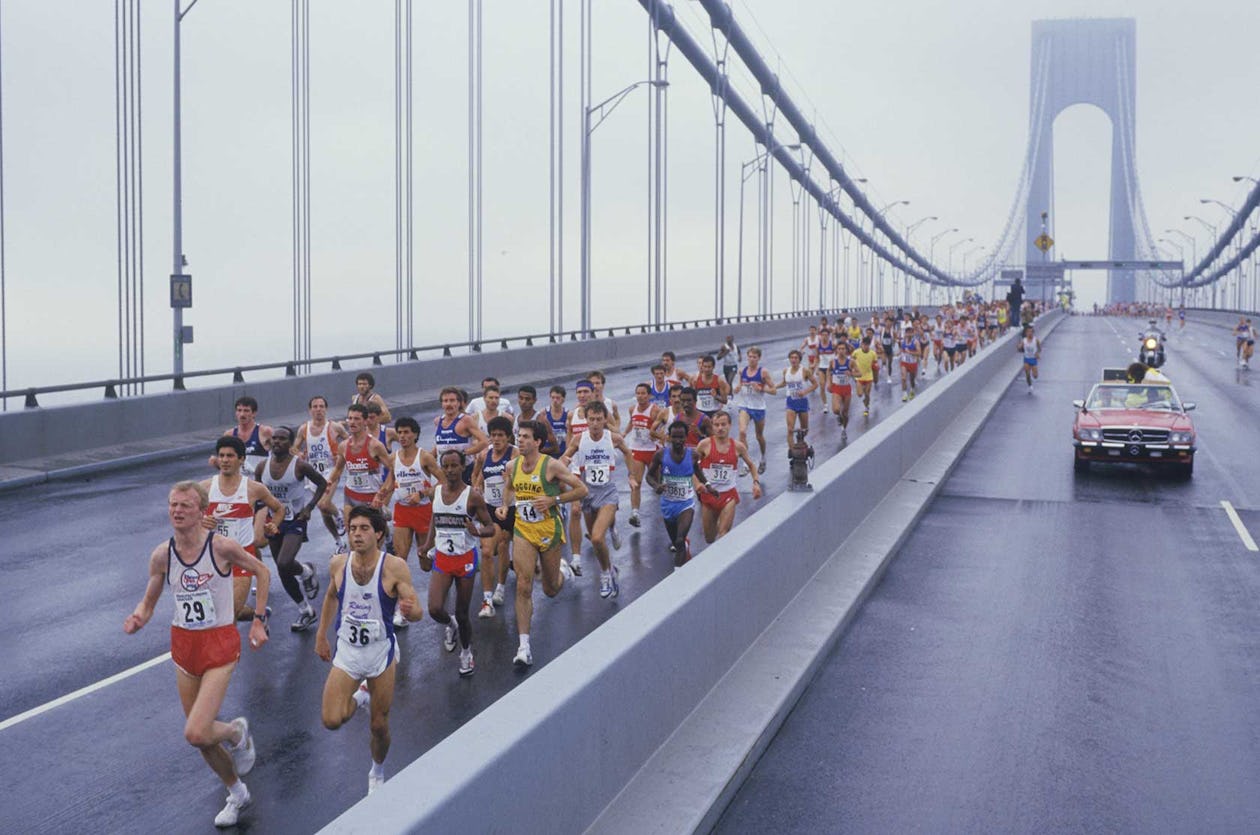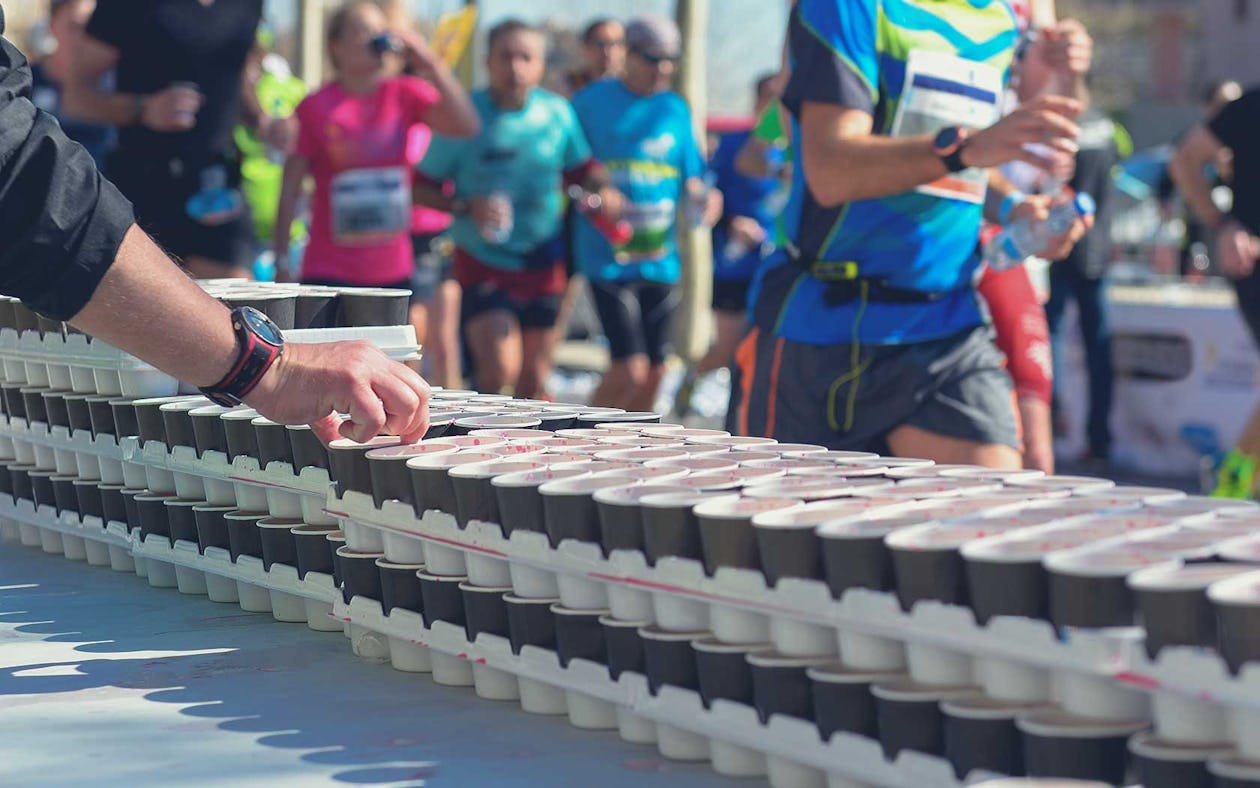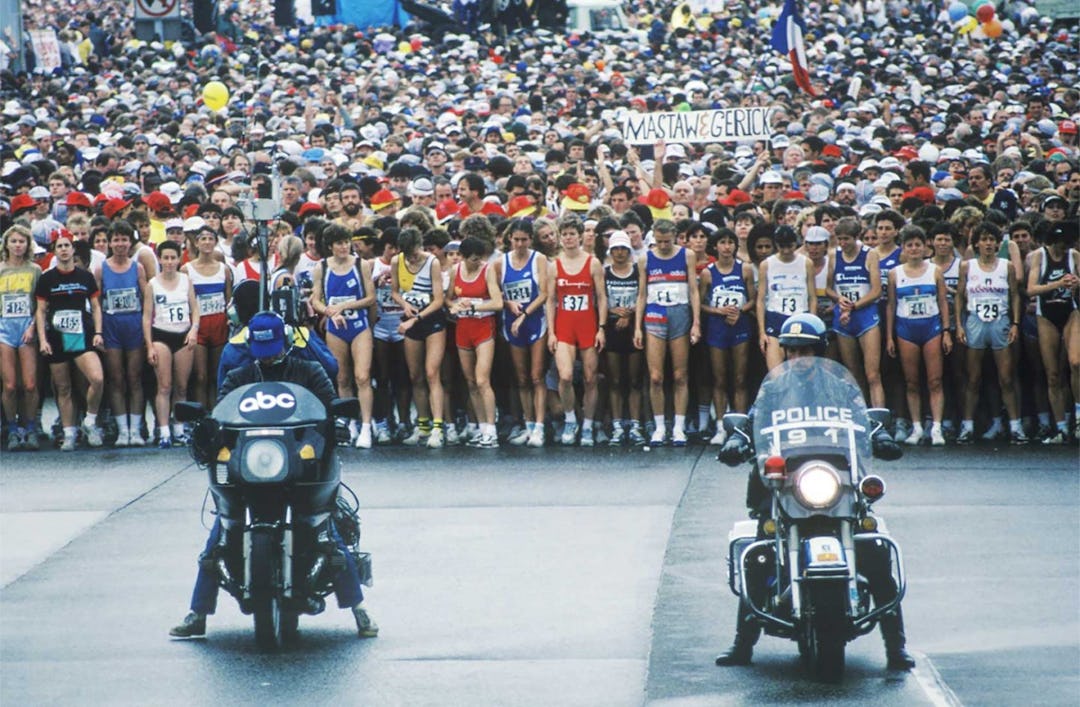It’s been two weeks since I crossed the finish line of the 2016 Chicago Marathon and the runner’s high still hasn’t quite worn off. It was my first marathon and while my body has mostly recovered from the 26.2 miles, I’m still in disbelief that I actually did it.
On an impulse that was both crazy and ambitious, I entered the race lottery earlier this year and had a “holy shit” moment when I found out I actually got in. After the initial shock, I (quite literally) hit the ground running.
If you’re looking to run your first marathon—or you’re curious about what it would take to run one—the following are my road-tested tips on everything from training and nutrition to mindset and gear.
Four Months Out
You have to ask yourself, “Why do I want to do this?”
Before you take on a marathon race, dig deep and really think about what your “why” is. A 26.2-mile race is an enormous mental, emotional, and physical test that begins months before you even get to the start line.
Every ounce of you will be called upon to get through it, and if your motivation isn’t clear and strong, you’re in for a very long day. Knowing and remembering why you wanted to run a marathon in the first place will give you the strength to see it through.
Personally, I think I was looking for myself in doing it. And while I didn’t know that when I signed up for the marathon, I quickly learned it. I’ve always felt that I am my best self when I am training for a race.
Training for half-marathons made me feel so much better and stronger than I had ever been, so I could only imagine what training and running a full marathon would feel like. Doing so introduced me to a new version of me—a person that was unafraid, unstoppable, and dedicated to achieving a goal.
Train with an expert.
Whether you read blogs like this one, join a running group, or hire a coach, seek out some kind of authority that can provide guidance. I joined a local running group in Austin, TX, called Gilbert’s Gazelles.
They provided everything from weekly training schedules to one-on-one form training, so this group was a game-changer for me. We even had our own water stations set up for long runs.
My pace during the marathon was almost a minute faster than it was for my last half-marathon, and it was three minutes faster than my first half-marathon. I credit it mainly to my work with the Gazelles.
Run fast, run slow.
You should run at least three times a week. Two of your weekly training runs should be speed workouts, where you work at a pace that’s faster than what you’ll run in the race, and one should be a slower run, where you go at a comfortable pace for more miles.
My speed days included Fartleks, Yassos, and progressive runs. (Don’t worry, before I started training, I didn’t know the meaning of most of these words either.)
Fartleks are where you run intervals at your marathon goal pace alternated with rest. Yassos are track workouts where you run 800-meter repeats in your goal marathon time—just substitute minutes and seconds for hours and minutes.
So, for example, if you want to finish the race in three hours and 30 minutes, your 800-meter time should be three minutes and 30 seconds (3:30). Progressive runs are where you increase your speed progressively over the course of a run, getting a little faster with each mile.
I generally ran between five and seven miles each workout.
Increase mileage gradually.
You run a marathon one mile at a time, and that’s the same way you should train for one. My first few long, slow runs were daunting, but my team constantly reminded me that the purpose of long runs is to build endurance.
You don’t need to be worried about pace so much as just getting through them.
Eventually, you’ll want to start to work marathon goal pace timing into the last few miles of your long runs so you mimic the level of fatigue you would feel during the actual race and prepare yourself to push hard no matter how tired you are.
But running speed will come mainly by way of your speed days. Follow your schedule closely and don’t make dramatic leaps in mileage.
The rule of thumb is to never increase mileage by more than 10% week to week. My program increased mileage by one to two miles each week and then backed it off one to two miles every other week.
Find buds to run with.
Getting up at 4:30 a.m. on a Saturday to run 20 miles seems not only masochistic to non-runners but also completely neurotic. This is why having people around you who “get it” is so important.
Having other runners to bond with provides a support system that will help you keep going when you think you can’t.
There is no substitute for running.
There are times when traveling for work or vacation will make it hard to get a run in, but don’t kid yourself that an hour on the elliptical or stairclimber is good enough.
Crosstraining is one thing (more on this later), but ultimately there is no substitute for actually running. Your bones need to be conditioned for the pounding they get hitting the pavement.
I found that waking up before everyone and finding a cool, new running route once in a while made it easier to stick with the schedule.
Recovery runs are boring, but necessary.
Having two sessions a week where you run a minute or two slower than your goal time gives your body a break and flushes out toxins from your muscles. When you go back to working at your goal time you’ll feel like you’re flying.
Do recovery runs for 30–60 minutes. Fit them in on your off days and, ideally, on a trail or track rather than a paved road so your joints get a break. Don’t skip these workouts.
Don’t forget to cross-train.
Do some other kind of training in addition to running that serves the end goal. I did cycle, barre, and/or yoga classes two to three times each week. For upper-body and core strength, I would do pushups in the morning and again before bed.
Just do something you enjoy. The stronger you are, the faster you will be, and the less risk of injury you will have.
Don’t be afraid to rest.
You need one or two days each week of full rest. Embrace it—it’s well-earned time off. To help my recovery along, I foam rolled my IT bands, hamstrings, calves, quads, and lower back. Anywhere from 20 to 40 minutes really helps.
Then I iced sore areas with homemade ice packs. To make them, I simply put Dixie cups filled with water in the freezer. You can peel back the top part of the cup to reveal the ice while you comfortably hold the bottom half.
Then I followed it all up with a 20-minute bath using one to two cups Epsom salts and one cup apple cider vinegar. Salt baths fight inflammation and the vinegar is a natural detoxifier.
Drink post-workout protein.
Protein is necessary for muscle recovery, so I like to get some within 30 minutes of every workout. And don’t stop there. Be sure and have some form of protein with every meal. Skimping on protein in your meals is not an option when you’re training.
The International Society of Sports Nutrition recommends that endurance athletes take in 0.45–0.72 grams of protein per pound of their body weight. So a 130-pound runner would need roughly between 60 and 90 grams daily.
Alternate your running shoes.
This is good for a few reasons. One, your feet won’t be as susceptible to blisters because your foot lands differently from shoe to shoe, and that changes where the shoe rubs you.
Two, it will give the foam in your shoes a chance to reshape—it will bounce back a little rather than continue to be crushed in the shape of your foot.
Three, you will extend the life of whichever pair is your favorite, so you won’t be trying to break in a set of new shoes right before the race.
If you’ve never been fit for running shoes, I recommend having a pro help you out. Luke’s Locker, a popular Texas chain, is great for this. They will take a look at your run and gait (the way you step) to find a shoe that fits not only your foot but your running style.
My go-tos were the Sacucony Triumph ISO and the Brooks Ghost 9. It’s best to switch between a light pair of shoes for training days and a more padded shoe for long runs.
You can also switch them up depending on the type of surface you’re running on. For example, tracks are pretty cushioned already, so you can get away with a lighter shoe on those days. I also used a wearable attached to my shoes called the Milestone Pod.
In addition to tracking your pace, it also tracks your shoes’ mileage so you know when it’s time to toss a pair (usually after 300–400 miles).
Plan your race weekend.
Arrange everything you’re going to do the day before and day of the race ahead of time so you’re not frantically booking hotels and flights at the last minute. Aim to book a hotel that is very near the start or finish line of the marathon.
For big races, cabs can be hard to catch all weekend due to the influx of people, so situating yourself as close as possible will help make the morning of the marathon less chaotic (or getting back to your room afterward much easier).
As far as packing goes, I put all my race day essentials—shoes, clothes, gels, pre-workout supplement, and anything else I need during the run—in my carry-on bag.
So even if the rest of your luggage gets lost, you’ll still have everything you need to complete your mission.
Deal with injuries immediately.
What starts as a minor ache can become serious if you try to ignore it. As soon as you notice something feels off, schedule an assessment with a physical therapist. It’s better to prevent an injury than recover from one.
Unfortunately, I had to learn this the hard way. I had a sore knee that turned into excruciating, stabbing pain during one of my long runs. I let my IT band get aggravated to the point of causing bursitis.
This is one of the most common injuries among runners and I was lucky to catch it with enough time to recover before my race, but it could have been much worse. I immediately went to Mondo Sports and started a regular routine of physical therapy.
I took my homework pretty seriously and did all of the exercises and stretches they gave me each day.
Hydrate like a mofo.
The day before a long run, I found that mixing coconut water with equal parts regular water helped obtain optimal hydration without taking in loads of extra fluid that made me feel bloated.
I’m 5’3”, 115lbs, and would aim to drink 3,000-5,000ml of this mix each day in the 72 hours before a long run. I was also training during the summer months in Austin, Texas, so it was incredibly hot and dehydration was a high risk.
Remembering how much to drink can be tricky. Trago makes a water bottle cap that tracks your fluid intake.
2-3 Weeks Out

Start to taper.
Your coach will have a plan for this, but two to three weeks out you will want to start tapering. This means reducing your mileage and focusing more on shorter speed workouts. There are lots of schools of thought on this, but my program had a mild taper.
This meant pulling back on the long run mileage four weeks before the race. For me, that was going from 22–24-mile runs down to 18, 16, 14 and 12 miles on the long runs, but maintaining five to seven-mile runs on the speed days.
My goal was to do as much as I could to maintain endurance, but some programs will start scaling back much sooner than that.
Have a dress rehearsal.
There’s an old saying: “Nothing new on race day.” From your sports bra and underwear to your socks and earbuds, try everything that you’re going to wear or use for at least one long run before the race.
Even wearing a hat you’ve never worn before could be problematic if it starts to blow off or there’s a tag on it that itches the back of your head. Leave nothing to chance.
72 Hours Out
Study the course and run the last 3 miles.
Check the topography of your route online. Get an idea of when to anticipate hills and mentally prep for the elevation change. The day or two before, run or walk the last 3 miles of the course.
It will give you an idea of how far you have to go when the fatigue is unbearable. Knowing exactly how much farther you have can really help you dig deep and gut out those last few miles.
24 Hours Out

Go to bed early.
The night before felt a little like Christmas Eve. The moment I had been anticipating for so long was finally here and I was almost too excited to sleep. I went to bed early because the nerves took some time to settle.
Using a guided bedtime meditation with an app like Headspace or The Honest Guys helped me, along with rubbing some essential lavender oil onto my temples.
Eat a solid dinner.
I was pretty anxious and had a hard time getting food down, but I forced it. I wanted a healthy meal that I knew would not present any GI issues, so I found a Snap Kitchen near our hotel and picked up two servings of chicken and sweet potatoes.
Don’t eat anything weird.
If your marathon is in Chicago, you may be tempted to try some deep-dish pizza. If it’s in Philly, you may want a cheesesteak. Don’t. At least not until after the race.
From heartburn to bloating, a number of undesirable side affects could occur that can ruin all your hard work. Stick to simple foods you know your body can handle and save the fun foods for later.
2 Hours Out
Hydrate.
A friend of mine in the Special Forces told me a trick they use before long ruck marches. Drink 500ml of water two hours beforehand. Having to take a potty break during the race was a big fear of mine, and this method saved me.
It was the perfect amount of time and ounces before the start.
Eat one hour before race time.
I took this tip from Olympic marathoner Shalane Flanagan. Food wise, don’t do anything differently. Make the meal you’ve eaten before all your long runs and have perfected throughout the training season.
Don’t think because it’s race day you need to add an extra scoop of anything. That could cause stomach upset during the race.
Take your vitamins.
In addition to omega-3 fats and a pre-workout energizer, I used Onnit’s Shroomtech Sport to power my runs. It was like a secret weapon.
The adaptogen blend, vitamin B12 and cordyceps support ATP and deliver a dose of energy and stamina.
I also like that all the ingredients and carriers are clean, so I could trust I wasn’t putting junk into my bod.
During the Race

Don’t start too fast.
Don’t let the hype of the start corral get you too excited. A lot of runners get too amped up and start the race running well above their intended pace, which can leave you gassed almost right out of the gate. I was lucky that our coach had prepped us for this.
Let everyone else pass you and know that you will catch them a few miles in.
Have a plan.
And be prepared for it to all go to shit. I used the MARCO method, which is a negative split plan and I highly recommend it. Negative splits basically mean you start out slow and run the race increasingly faster.
With the MARCO method, you break the race into four parts, and you increase your speed in each quadrant by 10 seconds. They make bracelets you can order for your goal times, but I just wrote my splits down my arm with Sharpie big enough to see at a glance.
With all that said, be prepared that your watch may lose GPS signal and you could lose track of your timing. If that happens, trust your gut and your training and just run, baby, run.
Grab the water and go.
Get water and Gatorade at every stop, no matter what. If you get thirsty, it’s already too late.
Depending on the size of your race, the water stations will likely be very chaotic. There are hands reaching out, cups being smashed on the ground, and Gatorade flying in your face. Check your race information, but most stations are two blocks long.
Stay in the center of the road for as long as you can and as you near the end of the station, the crowd will thin out. Make your way at a diagonal and snag a cup from someone handing them out toward the end of the block.
Insider’s tip: as you grab the paper cup, pinch the rim so you make a funnel. This will help you get it down quicker without the liquid running up your nose or down your shirt.
Take an energy gel every 5 miles.
If you don’t, your body will find a way to get fuel, and it will take it from your muscles and bones. Refuel with quick hits throughout the race to restock your glycogen levels. Always take your gel before you think you need it.
Once you’re feeling fatigued, it’s much harder to recover.
My top gel choice was Honey Stinger Gold, which had the most carbs (27g) and potassium (85mg) per serving of all the brands I found. This is a good mix for when your energy reserves are running low. I also liked the chocolate flavor, which has 32mg of caffeine.
I saved that one for mile 25. I stored them in my Lululemon Stuff Your Bra sports bra, which has built in pockets for things like this. It made grabbing them extra easy.
Mile 22–24
It’s going to start to hurt, badly. This is where you will need to start calling upon your mental endurance. Remember why you wanted this and go back to that. And have mantras ready to go. Mine was, “There will come a day when you cannot do this.
Today is not that day.”
Miles 25–26.2
I was unexpectedly emotional at this point. I’m sure it was partly from pain, but it was also the crowds cheering. I started to cry. No matter how bad it hurts or how foggy your brain gets, don’t let anything stop you. You’re almost there.
After the Race
1. Stretch, foam roll and take an ice bath. Probably in that order.
2. Eat! I felt really sick for two days after the race. But try and force food down. You’ve burned around 2,600 calories and depleted all your nutrient reserves. Time to recover and replenish.
3. Recover for a couple weeks. Take it easy but don’t do nothing. Walk around the day after. Go see the sights. Light activity will help flush out your muscles.
4. And finally, celebrate. Whatever the outcome is, take a moment to honor what you’ve done. Be proud. Have a beer. You deserve it.

)





